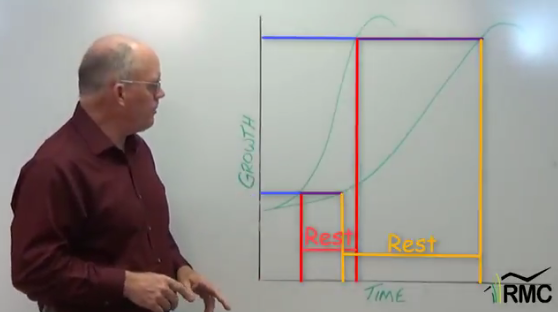“And all trees bear an awful big crop which the stock like so well that they will break down the fence to get them.”
-J Russell Smith, Tree Crops (1929)
 If you’re a grazier in all but the most frozen regions of the country, or perhaps the most sweltering parts of Florida, the honey locust tree can provide you with valuable stockpiled feed during the fall and winter months. If you haven’t already, read an introduction to the use of honey locust as stockpile, and a calculation of just how much extra feed we’re talking about. (Spoiler: It could double the feed produced on your land).
If you’re a grazier in all but the most frozen regions of the country, or perhaps the most sweltering parts of Florida, the honey locust tree can provide you with valuable stockpiled feed during the fall and winter months. If you haven’t already, read an introduction to the use of honey locust as stockpile, and a calculation of just how much extra feed we’re talking about. (Spoiler: It could double the feed produced on your land).
Now, let’s look at honey locust pods used as feed from a nutritional standpoint.
Let’s be absolutely clear from the outset that I am no nutritionist, for livestock, humans or otherwise. So, I’ll be leaning on the insights of others.
Let’s start with the basics
Honey locust pods tend to drop from November through January, and most pods tend to be on the ground by January 1. Some late varieties are still holding on to a quarter of their pods as I write this partway through January. This time frame means pods will be supplementing your stockpiled feed over the winter months. Livestock will gather pods from the ground, where they can last for months once they’ve fallen.
Weather does have an impact on pod quality. Warm, wet weather will cause faster deterioration of feed quality than will consistently freezing and dry conditions. The best place of all to store pods is on the tree, before they’ve fallen. Genetic selections where the tree holds on to its pods until February or March would be fantastic finds.
Sugar/Energy and Protein Values

Honey locust pods are particularly high in sugar, and genetics make a huge difference in the sugar content. Nutritional analysis we’ve done of ‘wild’ varieties (ornamental trees, and not selected for high-energy pods) show sugar content at 17% sugar content. Not bad until you compare that to selected varieties with 29% and 37% sugar. That’s a lot of energy!
Pods can also be a good source of protein, which is mainly found in the seeds. In our sampling, wild trees showed highest protein content at 12.2%, with the lowest protein (9.6%) being found in our highest sugar producer.
Here’s a caveat with protein: most is locked up inside a hard seed coat, and thus not equally accessible to all livestock. That seed coat needs to be broken in order to get to the protein in the seed. This can be done mechanically if pods are collected and then fed (which would allow feeding to hogs and poultry as well), but that of course requires labor. Sheep and goats make better use of the seeds than cattle. This is because sheep and goats have smaller openings between their rumen and omasum. This requires more chewing, which breaks the seed coat. While cattle can make great use of honey locust pods for their energy, their lack of ability to digest the seed means they’ll need high-protein forages to provide balance.
We can also look at Total Digestible Nutrients (TDN) to see how honey locust pods match up to animals needs. Total digestible nutrients add up the digestible fiber, protein, lipid, and carbohydrate components of a feedstuff or diet and is useful evaluating beef cow diets that are primarily forage. Our analysis showed TDN values of 68.4%, 67.6, and 69.4% for the three different varieties. The table below shows what a cow requires, and as you can see, honey locust does fit the bill for TDN and protein.

What we know from feed trials
The most thoroughly documented source of information on honey locust pod nutrition is from a study with sheep in France in 1993. Here’s what they learned:
“The pod feeding trials produced encouraging results: sheep fed a daily ration of 1.4kg (3 pounds) of whole honeylocust pods gained 135g/day (.29 pound) (1993 trials) and 178g/day (.4 pounds) (1994 trails). In a mixed diet, honeylocust pods have a high nutritive value and can provide sheep with between 25 and 50% of the required organic matter. (Foroughbakhch, 1995) Dupraz concludes that “[Honey locust] pods may therefore cover not only maintenance requirements but also production needs.”
“After two days of acclamation, sheep ate their entire pod ration. As the experiment progressed, some sheep reversed their initial reaction and increasingly preferred pods to alfalfa. Over the 7 week trail, net weight gains averaged 8 to 14kg/animal.”
“Higher in vivo digestibility could be achieved by:
1) feeding pods with a bulky feed (which would happen naturally in a silvopastural setting), and
2) propagating cultivars with softer seed to improve digestibility and increase protein digestibility (to as high as 70 to 80%). Depending on the clone, undigested seeds ranged from a low of 12% to a high of 33%.”
“Feeding whole pods is preferred to ground pods because of the higher digestibility (due to longer retention time), and avoidance of extra processing costs.”
“Sheep are able to digest the hard honeylocust seed. Because cattle can not digest the honeylocust seed, pods must be ground for cattle to receive the full protein value.”
As Dupraz and his colleagues suggest in the paper, cultivars with softer seed can improve the digestibility of honey locust seeds. While the overall protein content may go down, the digestibility of what is there will be higher.
Another route is to use only grafted female trees, so that seeds don’t fully mature. Using only grafted trees has other benefits as well, like knowing all of your trees will yield pods, and knowing they’ll all be thornless. Thorniness is a juvenile trait on honey locusts, meaning that there’s only thorns on the lower 15-or-so feet of the tree, and graft material taken from higher on the tree will create a thornless grafted tree. While grafted honey locusts are quite uncommon as of 2021, I’m working to drastically increase supply in the years ahead.
What portion of your winter feed should come from honey locust pods?

If you are able to stockpile 2,000 lbs./acre of forages for winter and want to supplement with 50% honey locust pods by weight, your target will be to produce 1,000 lbs. of pods. Depending on where you are, your tree genetics, maturity and care, you can do that with about 10 good honey locusts.
Now, if you plant 20 honey locusts/acre and find you have more pods than your livestock can use well, you’ve a good problem on your hands. It’s like having more dollar bills than will fit neatly into a wallet. Bust out the tractor and a wheel rake, pick up those pods and put them to use. Sell them to your neighbor. Feed them to your stock in the barn. Grind them as feed for poultry or hogs. Better yet, try your hand at this grain-free, perennial beer and party like it’s 1821!
It’s nature at its best!
That honey locust pods make good livestock feed just makes good sense if you understand what the tree is trying to do. Honey locusts want nothing more than their pods to be eaten! Unlike a maple, which uses the wind to spread its seeds, honey locusts (like persimmons and apples and pears) have gotten this far because animals like to eat their pods, then help the tree by depositing their seed in a steaming pile of dung. That’s what honey locust pods are designed for. If animals avoided them, the species would have gone extinct long ago. Nature is offering you a tree that provides high-energy feed in the depth of winter, and the opportunity to drastically slash your feed bills.
So, if your livestock could use more energy to fend off the cold, keep body condition and hit spring in great shape, look to honey locust for that next level of grazing profit.





Livestock are wonderful dispersal agents of honey locust. Feeding whole locust seed guarantees that you are going to have honey locust everywhere.
Well, that can depend. Often we don’t notice or even know when our livestock are grazing off young seedlings. A good example is my grandpa’s dairy cow pasture. It had a few trees on the fence lines, but for the 30-odd years I knew him and cows grazed there, there was nothing in the pasture itself. But after he left the farm and no one grazed that pasture it came up in trees everywhere. Meanwhile, other grazed pastures – no trees. So, yes, they can spread the trees, but grazing can prevent forests.
If you are talking about the variety of Honey Locust trees that produce thorns I would urge caution. Cattle love the pods as do deer. They do an excellent job of reseeding the thorn trees. I have seen many pastures destroyed by heavy infestations of Honey Locust trees. The trees become so thick, man nor beast can even walk through the area. We eliminated all the Honey Locust trees from our farm in sw Iowa ten years ago but still have to deal with over 500 new seedlings each year as deer transplant them from neighboring farms. The thorns destroy tires. Repair efforts can’t even find them. Try getting poked by one and you’ll likely end up at your local doctor getting help with the inflammation.
Comments are closed.